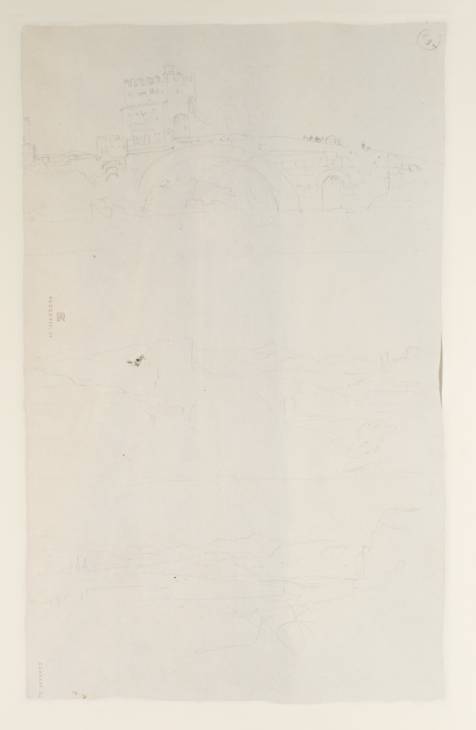Joseph Mallord William Turner 1775–1851
Three Sketches of Ponte Salario, Rome 1819
D41482
Turner Bequest CLXXXVII 34v
Pencil on white wove paper, 204 x 405 mm
Inscribed by the artist in pencil ‘Turf’, ‘P’ and ‘13’ within upppermost sketch
Inscribed by unknown hands in pencil ‘23- [encircled]’ top right, and ‘CLXXXVII.34’ bottom left, descending left-hand edge
Stamped in black ‘CLXXXVII 34’ descending centre left-hand edge
The subject of the three studies on this page is the Ponte Salario, a bridge in the Roman Campagna to the north of Rome which carried the ancient highway of the Via Salaria (Salt Road) across the River Aniene, close to where it joins the River Tiber.
1 As depicted in the uppermost and middle sketches the bridge comprised one large central arch with two smaller side arches, whilst the northern end of the crossing (left) was dominated by a defensive tower. Adjacent on the same side of the river and just visible to the far left of the most detailed study is a watch-tower. Sometimes known as the Torre Salaria, or the Tomb of Mario, this building was described by Ashby as ‘a large tomb of tufa concrete ... with a chamber in the form of Greek cross and a medieval tower above’.
2 It still survives today although the Ponte Salario was destroyed in 1867 by Papal and French troops defending Rome against Giuseppe Garibaldi.
3 On the recto of this sheet, Turner made a coloured study of the confluence of the Tiber and Aniene rivers with the bridge and tower in the middle distance (see D16122; Turner Bequest CLXXXVII 34). Further studies can also be found on D41514; verso of CLXXXVII 33.
The Ponte Salario was one of a number of bridges and ancient monuments in the Roman Campagna which had become a popular subject for topographical artists. Turner’s sketches recall similar studies by Claude Lorrain,
4 and Italian
vedutisti, Giovanni Battista Piranesi (1720–1778 )
5 and Giuseppe Vasi (1710–1782).
6 Turner has repeated the same compositional formula of depicting the bridge at an oblique angle from the south-west so that the visual impact of arches and tower is maximised and so that the Torre Salaria can also just been seen to the left.
Accepted by the nation as part of the Turner Bequest 1856

